Comprehensive Risk Assessment and Management Report for Telstra
VerifiedAdded on 2020/05/28
|6
|1370
|249
Report
AI Summary
This report provides a comprehensive risk assessment and management analysis for Telstra Company. It identifies key micro factors influencing Telstra's performance, including financial, operational, technological, ethical, project, and safety risks. The report emphasizes the importance of an Enterprise Risk Management (ERM) structure to manage these risks effectively. It delves into specific risk categories such as industrial disruption, competition, financial instability, operational failures, data governance, and technology-related threats. The report underscores the necessity of sound risk management in each area to prevent losses, maintain a strong market position, and ensure sustainable growth. Furthermore, it highlights the benefits of proactive risk management in enhancing decision-making, fostering stakeholder relationships, and promoting overall company resilience. The report concludes by stressing the importance of a robust IT department and continuous adaptation to technological advancements to mitigate emerging risks.
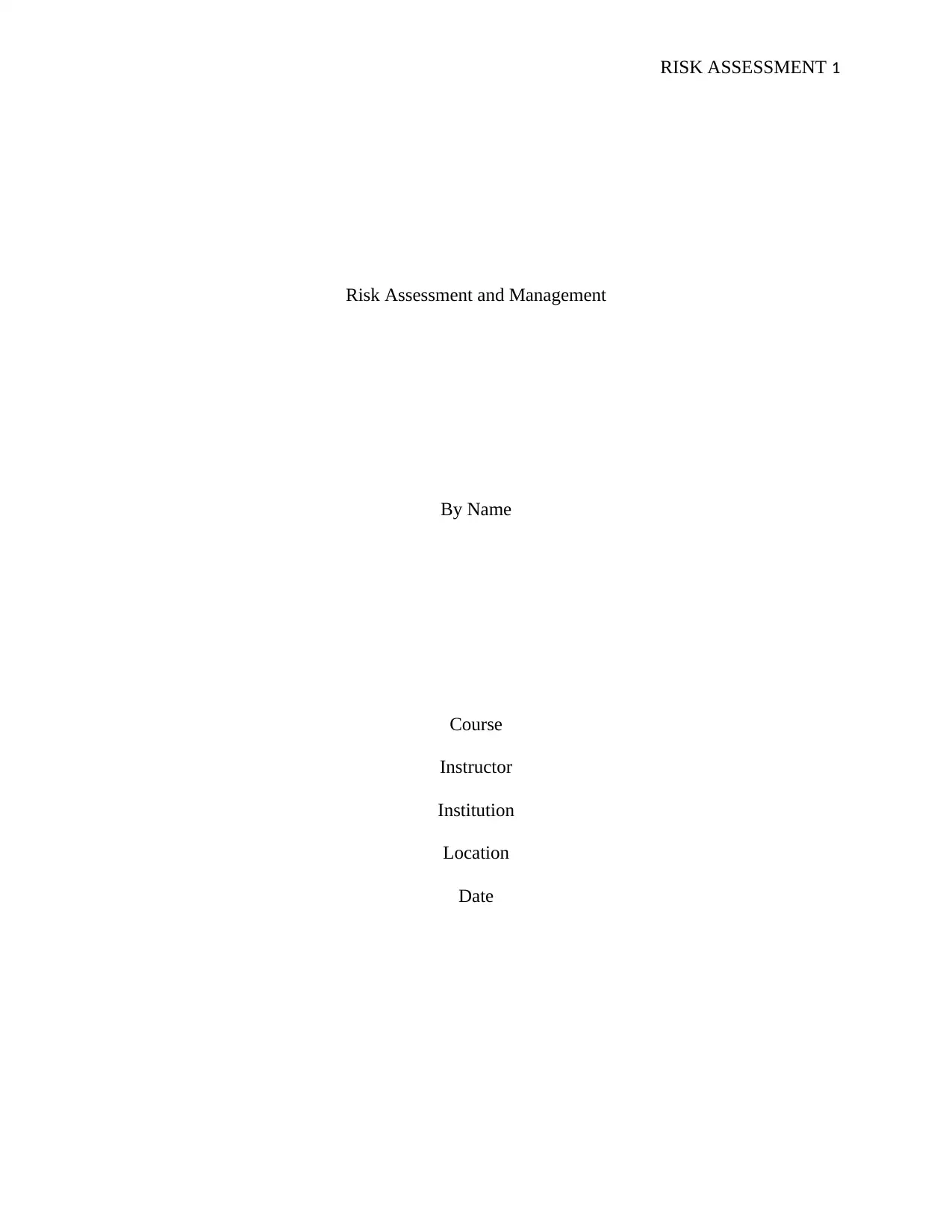
RISK ASSESSMENT 1
Risk Assessment and Management
By Name
Course
Instructor
Institution
Location
Date
Risk Assessment and Management
By Name
Course
Instructor
Institution
Location
Date
Paraphrase This Document
Need a fresh take? Get an instant paraphrase of this document with our AI Paraphraser
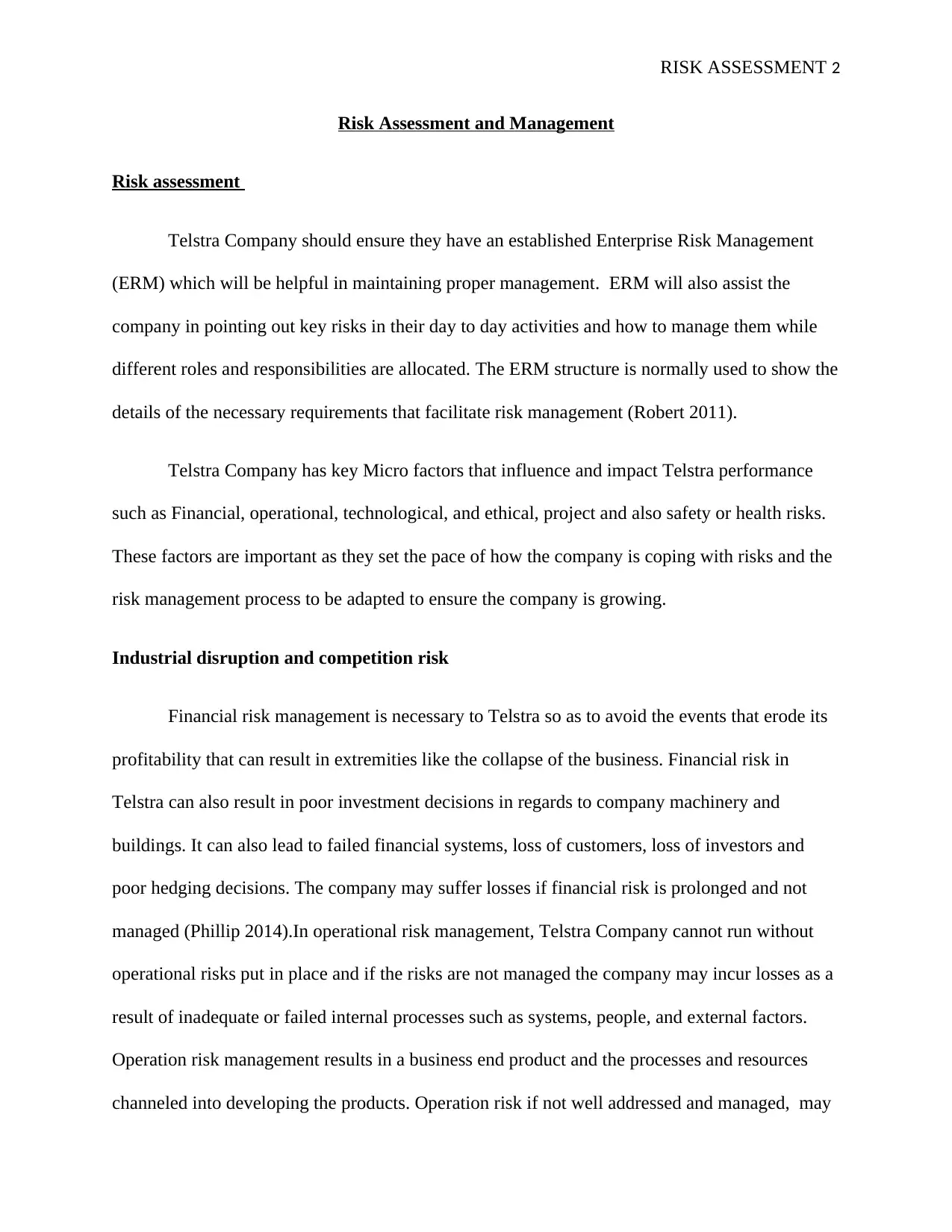
RISK ASSESSMENT 2
Risk Assessment and Management
Risk assessment
Telstra Company should ensure they have an established Enterprise Risk Management
(ERM) which will be helpful in maintaining proper management. ERM will also assist the
company in pointing out key risks in their day to day activities and how to manage them while
different roles and responsibilities are allocated. The ERM structure is normally used to show the
details of the necessary requirements that facilitate risk management (Robert 2011).
Telstra Company has key Micro factors that influence and impact Telstra performance
such as Financial, operational, technological, and ethical, project and also safety or health risks.
These factors are important as they set the pace of how the company is coping with risks and the
risk management process to be adapted to ensure the company is growing.
Industrial disruption and competition risk
Financial risk management is necessary to Telstra so as to avoid the events that erode its
profitability that can result in extremities like the collapse of the business. Financial risk in
Telstra can also result in poor investment decisions in regards to company machinery and
buildings. It can also lead to failed financial systems, loss of customers, loss of investors and
poor hedging decisions. The company may suffer losses if financial risk is prolonged and not
managed (Phillip 2014).In operational risk management, Telstra Company cannot run without
operational risks put in place and if the risks are not managed the company may incur losses as a
result of inadequate or failed internal processes such as systems, people, and external factors.
Operation risk management results in a business end product and the processes and resources
channeled into developing the products. Operation risk if not well addressed and managed, may
Risk Assessment and Management
Risk assessment
Telstra Company should ensure they have an established Enterprise Risk Management
(ERM) which will be helpful in maintaining proper management. ERM will also assist the
company in pointing out key risks in their day to day activities and how to manage them while
different roles and responsibilities are allocated. The ERM structure is normally used to show the
details of the necessary requirements that facilitate risk management (Robert 2011).
Telstra Company has key Micro factors that influence and impact Telstra performance
such as Financial, operational, technological, and ethical, project and also safety or health risks.
These factors are important as they set the pace of how the company is coping with risks and the
risk management process to be adapted to ensure the company is growing.
Industrial disruption and competition risk
Financial risk management is necessary to Telstra so as to avoid the events that erode its
profitability that can result in extremities like the collapse of the business. Financial risk in
Telstra can also result in poor investment decisions in regards to company machinery and
buildings. It can also lead to failed financial systems, loss of customers, loss of investors and
poor hedging decisions. The company may suffer losses if financial risk is prolonged and not
managed (Phillip 2014).In operational risk management, Telstra Company cannot run without
operational risks put in place and if the risks are not managed the company may incur losses as a
result of inadequate or failed internal processes such as systems, people, and external factors.
Operation risk management results in a business end product and the processes and resources
channeled into developing the products. Operation risk if not well addressed and managed, may
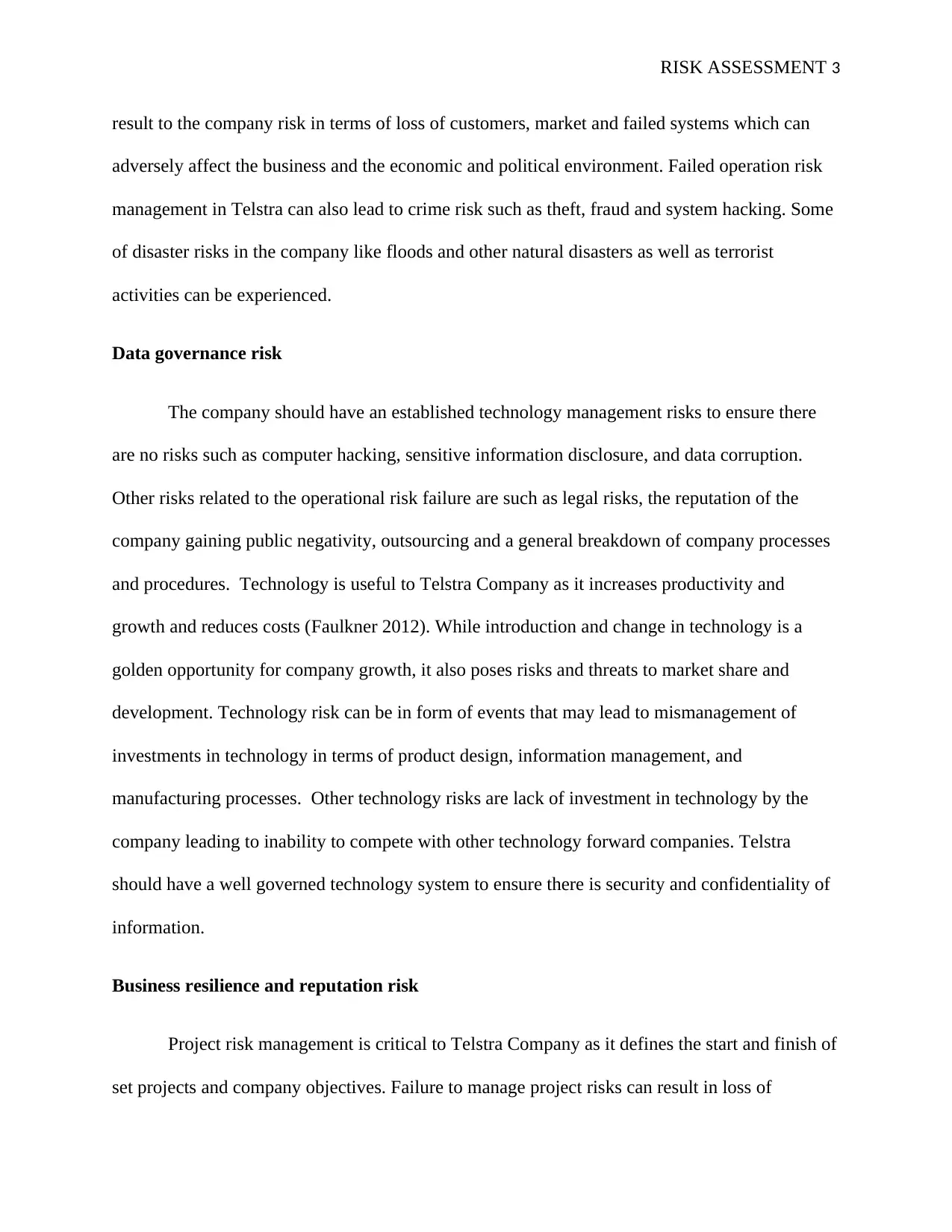
RISK ASSESSMENT 3
result to the company risk in terms of loss of customers, market and failed systems which can
adversely affect the business and the economic and political environment. Failed operation risk
management in Telstra can also lead to crime risk such as theft, fraud and system hacking. Some
of disaster risks in the company like floods and other natural disasters as well as terrorist
activities can be experienced.
Data governance risk
The company should have an established technology management risks to ensure there
are no risks such as computer hacking, sensitive information disclosure, and data corruption.
Other risks related to the operational risk failure are such as legal risks, the reputation of the
company gaining public negativity, outsourcing and a general breakdown of company processes
and procedures. Technology is useful to Telstra Company as it increases productivity and
growth and reduces costs (Faulkner 2012). While introduction and change in technology is a
golden opportunity for company growth, it also poses risks and threats to market share and
development. Technology risk can be in form of events that may lead to mismanagement of
investments in technology in terms of product design, information management, and
manufacturing processes. Other technology risks are lack of investment in technology by the
company leading to inability to compete with other technology forward companies. Telstra
should have a well governed technology system to ensure there is security and confidentiality of
information.
Business resilience and reputation risk
Project risk management is critical to Telstra Company as it defines the start and finish of
set projects and company objectives. Failure to manage project risks can result in loss of
result to the company risk in terms of loss of customers, market and failed systems which can
adversely affect the business and the economic and political environment. Failed operation risk
management in Telstra can also lead to crime risk such as theft, fraud and system hacking. Some
of disaster risks in the company like floods and other natural disasters as well as terrorist
activities can be experienced.
Data governance risk
The company should have an established technology management risks to ensure there
are no risks such as computer hacking, sensitive information disclosure, and data corruption.
Other risks related to the operational risk failure are such as legal risks, the reputation of the
company gaining public negativity, outsourcing and a general breakdown of company processes
and procedures. Technology is useful to Telstra Company as it increases productivity and
growth and reduces costs (Faulkner 2012). While introduction and change in technology is a
golden opportunity for company growth, it also poses risks and threats to market share and
development. Technology risk can be in form of events that may lead to mismanagement of
investments in technology in terms of product design, information management, and
manufacturing processes. Other technology risks are lack of investment in technology by the
company leading to inability to compete with other technology forward companies. Telstra
should have a well governed technology system to ensure there is security and confidentiality of
information.
Business resilience and reputation risk
Project risk management is critical to Telstra Company as it defines the start and finish of
set projects and company objectives. Failure to manage project risks can result in loss of
⊘ This is a preview!⊘
Do you want full access?
Subscribe today to unlock all pages.

Trusted by 1+ million students worldwide
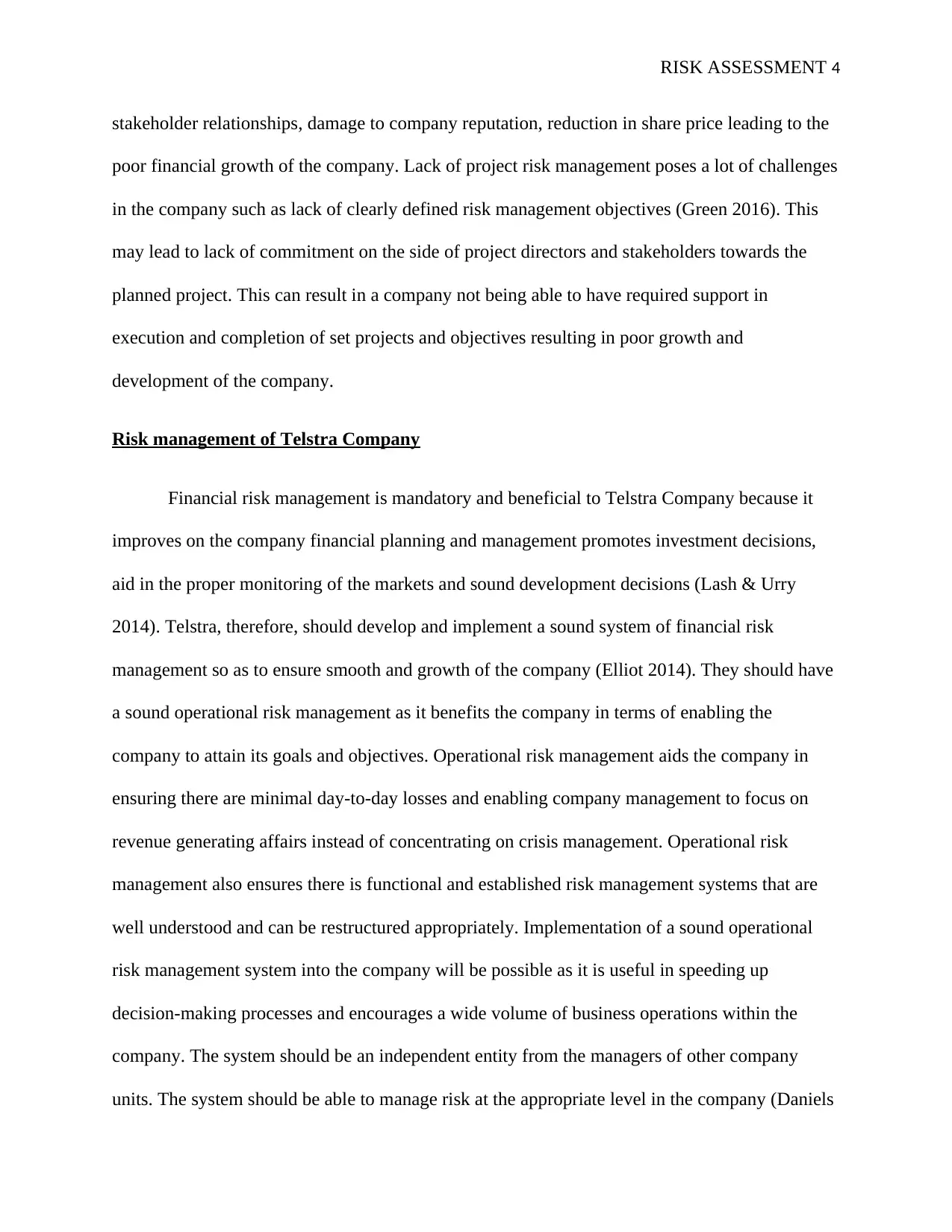
RISK ASSESSMENT 4
stakeholder relationships, damage to company reputation, reduction in share price leading to the
poor financial growth of the company. Lack of project risk management poses a lot of challenges
in the company such as lack of clearly defined risk management objectives (Green 2016). This
may lead to lack of commitment on the side of project directors and stakeholders towards the
planned project. This can result in a company not being able to have required support in
execution and completion of set projects and objectives resulting in poor growth and
development of the company.
Risk management of Telstra Company
Financial risk management is mandatory and beneficial to Telstra Company because it
improves on the company financial planning and management promotes investment decisions,
aid in the proper monitoring of the markets and sound development decisions (Lash & Urry
2014). Telstra, therefore, should develop and implement a sound system of financial risk
management so as to ensure smooth and growth of the company (Elliot 2014). They should have
a sound operational risk management as it benefits the company in terms of enabling the
company to attain its goals and objectives. Operational risk management aids the company in
ensuring there are minimal day-to-day losses and enabling company management to focus on
revenue generating affairs instead of concentrating on crisis management. Operational risk
management also ensures there is functional and established risk management systems that are
well understood and can be restructured appropriately. Implementation of a sound operational
risk management system into the company will be possible as it is useful in speeding up
decision-making processes and encourages a wide volume of business operations within the
company. The system should be an independent entity from the managers of other company
units. The system should be able to manage risk at the appropriate level in the company (Daniels
stakeholder relationships, damage to company reputation, reduction in share price leading to the
poor financial growth of the company. Lack of project risk management poses a lot of challenges
in the company such as lack of clearly defined risk management objectives (Green 2016). This
may lead to lack of commitment on the side of project directors and stakeholders towards the
planned project. This can result in a company not being able to have required support in
execution and completion of set projects and objectives resulting in poor growth and
development of the company.
Risk management of Telstra Company
Financial risk management is mandatory and beneficial to Telstra Company because it
improves on the company financial planning and management promotes investment decisions,
aid in the proper monitoring of the markets and sound development decisions (Lash & Urry
2014). Telstra, therefore, should develop and implement a sound system of financial risk
management so as to ensure smooth and growth of the company (Elliot 2014). They should have
a sound operational risk management as it benefits the company in terms of enabling the
company to attain its goals and objectives. Operational risk management aids the company in
ensuring there are minimal day-to-day losses and enabling company management to focus on
revenue generating affairs instead of concentrating on crisis management. Operational risk
management also ensures there is functional and established risk management systems that are
well understood and can be restructured appropriately. Implementation of a sound operational
risk management system into the company will be possible as it is useful in speeding up
decision-making processes and encourages a wide volume of business operations within the
company. The system should be an independent entity from the managers of other company
units. The system should be able to manage risk at the appropriate level in the company (Daniels
Paraphrase This Document
Need a fresh take? Get an instant paraphrase of this document with our AI Paraphraser
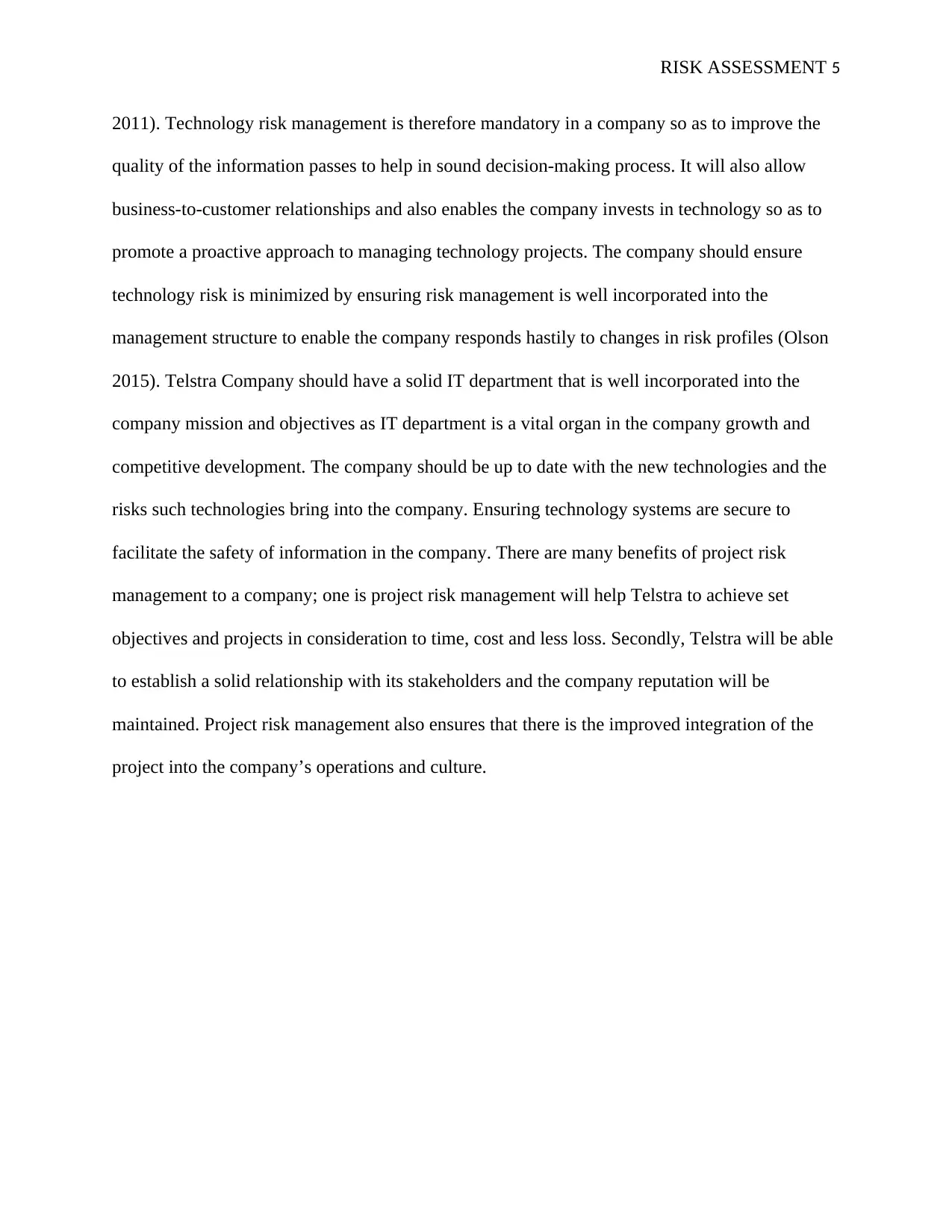
RISK ASSESSMENT 5
2011). Technology risk management is therefore mandatory in a company so as to improve the
quality of the information passes to help in sound decision-making process. It will also allow
business-to-customer relationships and also enables the company invests in technology so as to
promote a proactive approach to managing technology projects. The company should ensure
technology risk is minimized by ensuring risk management is well incorporated into the
management structure to enable the company responds hastily to changes in risk profiles (Olson
2015). Telstra Company should have a solid IT department that is well incorporated into the
company mission and objectives as IT department is a vital organ in the company growth and
competitive development. The company should be up to date with the new technologies and the
risks such technologies bring into the company. Ensuring technology systems are secure to
facilitate the safety of information in the company. There are many benefits of project risk
management to a company; one is project risk management will help Telstra to achieve set
objectives and projects in consideration to time, cost and less loss. Secondly, Telstra will be able
to establish a solid relationship with its stakeholders and the company reputation will be
maintained. Project risk management also ensures that there is the improved integration of the
project into the company’s operations and culture.
2011). Technology risk management is therefore mandatory in a company so as to improve the
quality of the information passes to help in sound decision-making process. It will also allow
business-to-customer relationships and also enables the company invests in technology so as to
promote a proactive approach to managing technology projects. The company should ensure
technology risk is minimized by ensuring risk management is well incorporated into the
management structure to enable the company responds hastily to changes in risk profiles (Olson
2015). Telstra Company should have a solid IT department that is well incorporated into the
company mission and objectives as IT department is a vital organ in the company growth and
competitive development. The company should be up to date with the new technologies and the
risks such technologies bring into the company. Ensuring technology systems are secure to
facilitate the safety of information in the company. There are many benefits of project risk
management to a company; one is project risk management will help Telstra to achieve set
objectives and projects in consideration to time, cost and less loss. Secondly, Telstra will be able
to establish a solid relationship with its stakeholders and the company reputation will be
maintained. Project risk management also ensures that there is the improved integration of the
project into the company’s operations and culture.
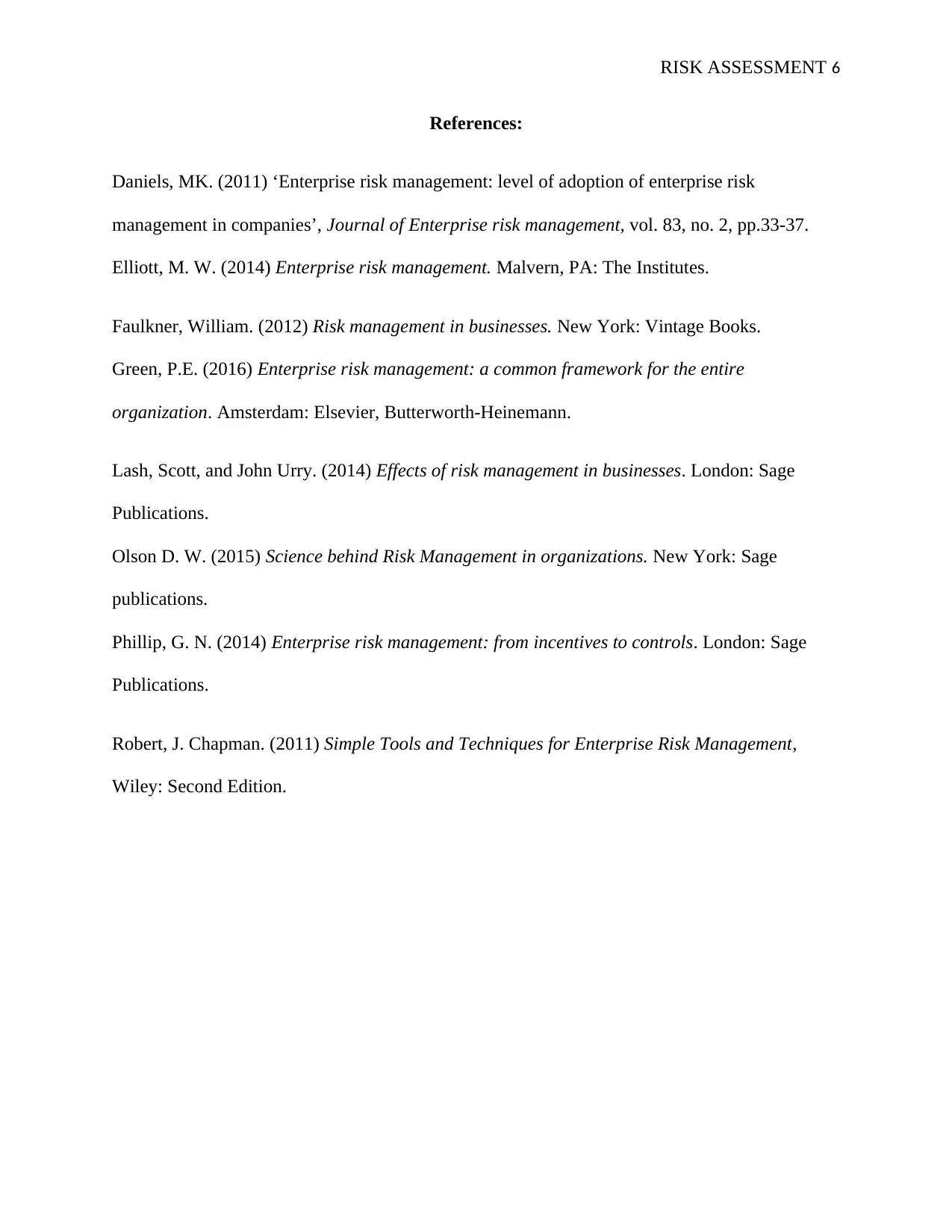
RISK ASSESSMENT 6
References:
Daniels, MK. (2011) ‘Enterprise risk management: level of adoption of enterprise risk
management in companies’, Journal of Enterprise risk management, vol. 83, no. 2, pp.33-37.
Elliott, M. W. (2014) Enterprise risk management. Malvern, PA: The Institutes.
Faulkner, William. (2012) Risk management in businesses. New York: Vintage Books.
Green, P.E. (2016) Enterprise risk management: a common framework for the entire
organization. Amsterdam: Elsevier, Butterworth-Heinemann.
Lash, Scott, and John Urry. (2014) Effects of risk management in businesses. London: Sage
Publications.
Olson D. W. (2015) Science behind Risk Management in organizations. New York: Sage
publications.
Phillip, G. N. (2014) Enterprise risk management: from incentives to controls. London: Sage
Publications.
Robert, J. Chapman. (2011) Simple Tools and Techniques for Enterprise Risk Management,
Wiley: Second Edition.
References:
Daniels, MK. (2011) ‘Enterprise risk management: level of adoption of enterprise risk
management in companies’, Journal of Enterprise risk management, vol. 83, no. 2, pp.33-37.
Elliott, M. W. (2014) Enterprise risk management. Malvern, PA: The Institutes.
Faulkner, William. (2012) Risk management in businesses. New York: Vintage Books.
Green, P.E. (2016) Enterprise risk management: a common framework for the entire
organization. Amsterdam: Elsevier, Butterworth-Heinemann.
Lash, Scott, and John Urry. (2014) Effects of risk management in businesses. London: Sage
Publications.
Olson D. W. (2015) Science behind Risk Management in organizations. New York: Sage
publications.
Phillip, G. N. (2014) Enterprise risk management: from incentives to controls. London: Sage
Publications.
Robert, J. Chapman. (2011) Simple Tools and Techniques for Enterprise Risk Management,
Wiley: Second Edition.
⊘ This is a preview!⊘
Do you want full access?
Subscribe today to unlock all pages.

Trusted by 1+ million students worldwide
1 out of 6
Related Documents
Your All-in-One AI-Powered Toolkit for Academic Success.
+13062052269
info@desklib.com
Available 24*7 on WhatsApp / Email
![[object Object]](/_next/static/media/star-bottom.7253800d.svg)
Unlock your academic potential
Copyright © 2020–2025 A2Z Services. All Rights Reserved. Developed and managed by ZUCOL.





